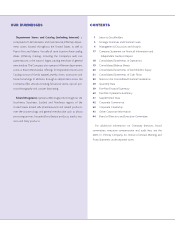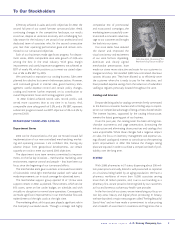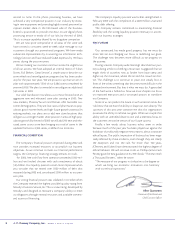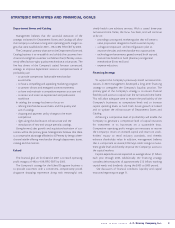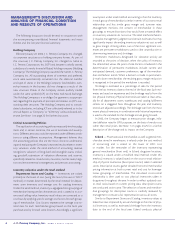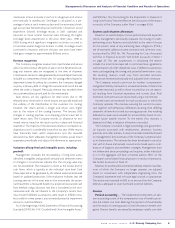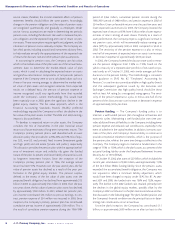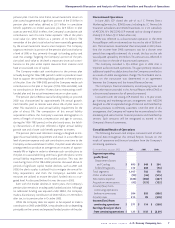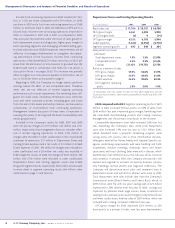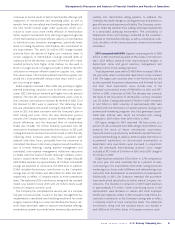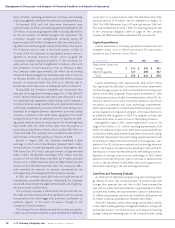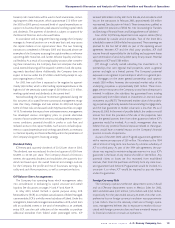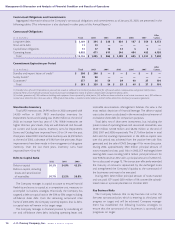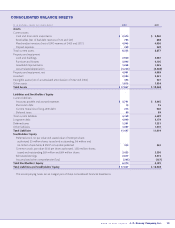JCPenney 2002 Annual Report Download - page 12
Download and view the complete annual report
Please find page 12 of the 2002 JCPenney annual report below. You can navigate through the pages in the report by either clicking on the pages listed below, or by using the keyword search tool below to find specific information within the annual report.
2002 annual report J. C. Penney Company, Inc. 9
Management’s Discussion and Analysis of Financial Condition and Results of Operations
continues to be the result of better merchandise offerings and
integration of merchandise and marketing plans, as well as
benefits from the centralized merchandising model. Benefits of
the new model include larger order quantities, which con-
tribute to lower costs; more timely selection of merchandise;
better supplier involvement from planning stages through sale
of the merchandise and more efficient delivery of merchandise
to individual stores. Inventory management, specifically lower
levels of catalog liquidation merchandise, also contributed to
the improvement. This year’s $6 million LIFO charge resulted
primarily from the decline of higher cost inventory layers in
certain categories of merchandise. Catalog’s reduced levels of
inventory drove the declines. Last year’s $9 million LIFO credit
resulted primarily from higher initial markup. As discussed in
Note 1 on pages 24-25, a change was made in 2002 to the LIFO
calculation to measure inflation based on supplier cost, rather
than retail values. The Company determined that supplier cost
would be a more preferable measure than retail, which is sub-
ject to pricing strategies.
SG&A expenses increased 1.9% in 2002 due primarily to higher
planned advertising, transition costs for the new store support
center (SSC) distribution network and higher non-cash pension
expense. The new SSC network for department stores is key to
the Company’s centralization initiative. By the end of 2002, 10 of
the planned 13 SSCs were in operation. The remaining three
SSCs are scheduled to be up and running by mid-2003. The tran-
sition to SSCs has been consistent with the Company’s plan in
both timing and costs. Once this new distribution process
matures, the Company expects to attain benefits through oper-
ational efficiencies and the improved flow of merchandise.
SG&A also includes $17 million primarily associated with the
severance for employees impacted by the transition to SSCs and
catalog distribution facilities that will be closed in 2003. Partially
offsetting these increases were reductions associated with
reduced store labor hours, principally from the conversion to
centralized checkouts in the stores, progress toward the elimina-
tion of in-store receiving, catalog expense management and
centralized store expense management. Additional reductions
to SG&A were the result of further reducing Company contri-
butions toward retiree medical costs. These changes reduced
2002 SG&A expenses by approximately $27 million. Annualized
savings are expected to continue at the 2002 level. In addition,
SG&A included discretionary contributions to the Company’s
savings plan of $20 million and $48 million for 2002 and 2001,
respectively, to reflect a Company match at more competitive
levels. The additional 2002 contribution, along with the standard
match, was funded in early 2003 with 2.4 million newly issued
shares of Company common stock.
The Company has completed the second year of a complex
five-year turnaround plan. As part of the plan, management has
implemented a centralized merchandising model and has made
progress toward rolling out a new merchandise distribution net-
work. Steps have been taken to improve merchandise offerings
and enhance systems to provide better inventory data and more
visibility into merchandise selling patterns. In addition, the
Company has made changes to catalog processes and policies to
gain efficiencies and improve profitability. The Company contin-
ued to make key external hires, adding individuals experienced
in a centralized operating environment. The profitability of
Department Stores and Catalog is impacted by the customer’s
response to merchandise offerings, as well as competitive condi-
tions, the effects of the current economic climate and consumer
confidence.
2001 compared with 2000. Segment operating profit of $548
million in 2001 more than doubled to 3% of sales, from the prior
year’s $254 million, primarily from improved gross margins in
department stores and good inventory management and
expense control in the catalog operation.
Total department store sales of $14.8 billion increased 1.5% for
the year, while sales in comparable department stores increased
3.3%. The largest sales increases were in the Home Division, led
by the expanded housewares department and followed by bed
and bath. Total department stores include sales in the
Company’s international stores of $498 million in 2001, and $547
million in 2000, a decrease of 9.0%. The decrease was primarily
the result of the fluctuation of the Brazilian currency translated
into U.S. dollars. Catalog sales were $3.4 billion in 2001 compared
to $4.2 billion in 2000, a decline of approximately 20%. Sales
declined with the elimination of several specialty catalogs and
promotional marketing programs that had generated unprof-
itable sales. Internet sales, which are included with catalog,
increased to $324 million from $294 million in 2000.
LIFO gross margin for 2001 improved 180 basis points as a
percent of sales compared with 2000. Margin improvement was
primarily the result of better merchandise assortments,
improved inventory productivity and benefits derived from cen-
tralized merchandising. In addition, 2000 included $92 million of
incremental markdowns on discontinued merchandise as
department store assortments were narrowed in conjunction
with the centralized merchandising initiative. Gross margin
included a LIFO credit of $9 million in 2001 and a LIFO charge of
$14 million in 2000.
SG&A expenses improved $156 million or 2.7% compared to
the prior year, and were essentially flat as a percent of sales.
Contributing to this improvement were lower catalog book and
marketing costs, lower order fulfillment and telemarketing costs
and a shift from development to maintenance of jcpenney.com.
Additionally, in 2001, the Company amended the post-retire-
ment medical and dental plans to further reduce Company con-
tributions. This resulted in a reduction of 2001 SG&A expenses
of approximately $11 million. Other contributing factors to the
improvement were decreases in salaries and other employee
benefit plan expenses. SG&A in 2001 included a $48 million dis-
cretionary contribution to the Company’s savings plan to reflect
a Company match at more competitive levels. This additional
contribution, along with the standard match, was funded in
early 2002 with 2.9 million shares of Company common stock.



